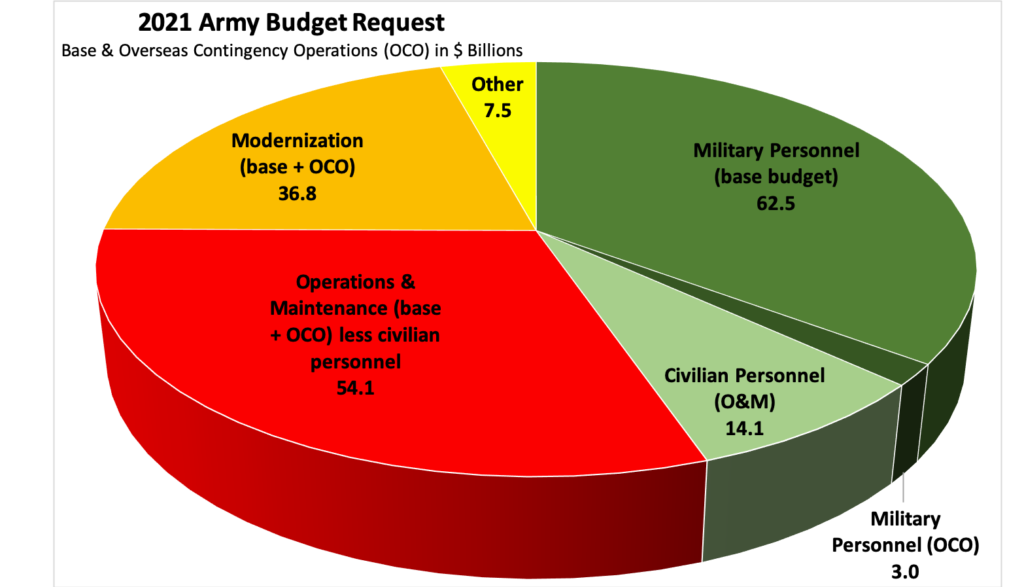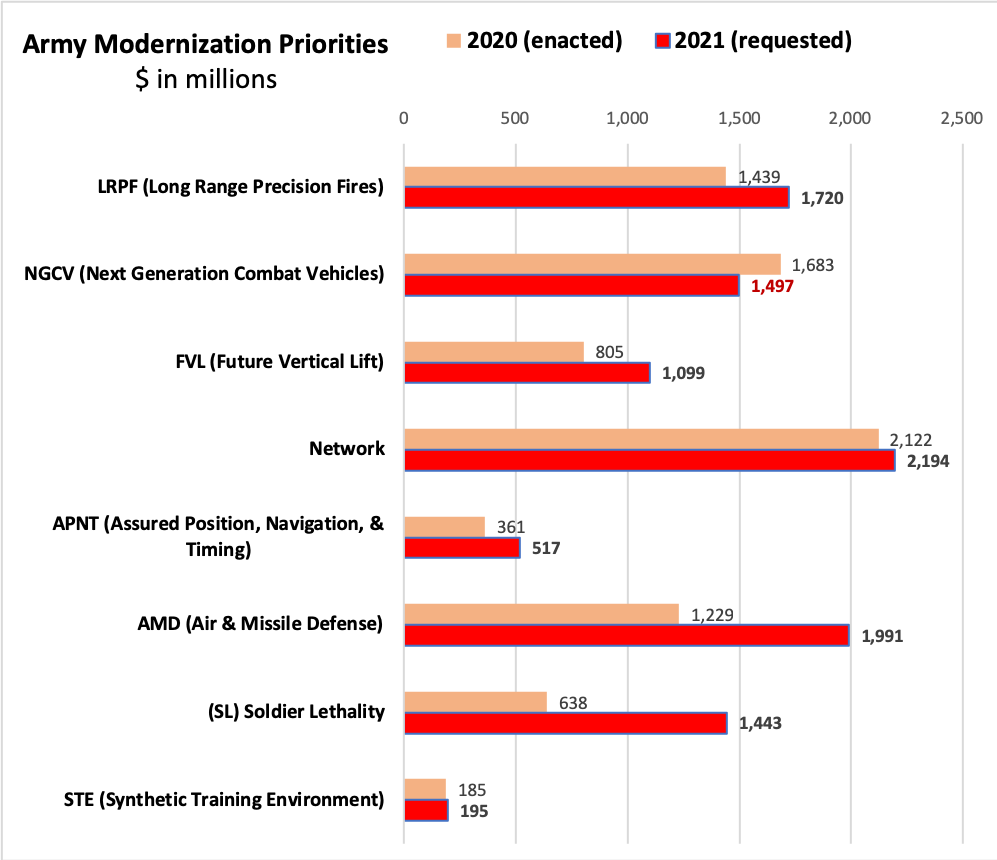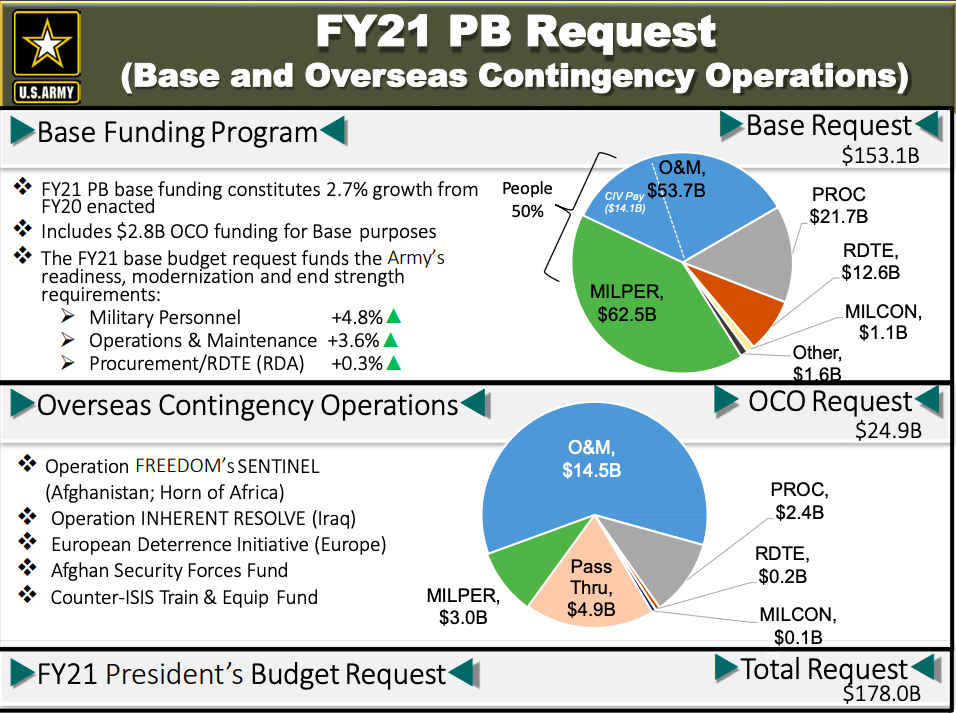
Breaking Defense graphic from Army data. Modernization equals Procurement plus RDTE (Research, Development, Test, & Engineering)
ARLINGTON: The Army’s inflation-adjusted buying power is eroding just as the service is ramping up modernization programs, the service’s top uniformed budget official said today. Something’s got to give and, while Lt. Gen. Thomas Horlander would like the whole budget to get bigger, the other possibility is that the size of the force goes down.
“If you look at that funding profile I showed you, it looks pretty flat,” Horlander said this morning at the Association of the US Army. “Well, when you factor in inflation, it’s actually a downturn … This year it’s about a one percent downturn in real purchasing power. We need real purchasing power growth, three to five percent.”
Horlander’s remarks are the latest in a drumbeat of complaints about the 2021 topline – the second and last to be constrained by the budget deal signed last August. While no one in the Defense Department has called for lifting the 2021 budget caps, they’re clearly laying the groundwork for a debate next year over the 2022 spending plan.
Even as he echoed Defense Secretary Mark Esper’s call for growth, however, Horlander couldn’t help mention the most expensive elephant in the room: military pay and benefits.

“No surprise, in our base budget about 50 percent of our funding goes to pay for our people,” Horlander said at AUSA. As he put it to reporters afterward: “I know $178 billion, by anybody’s standard, is a lot of money, but I gotta tell you — this is a million-man Army.”
In fact, the MILPERS account, not R&D, procurement, or operations, is the fastest-growing piece of the Defense Department’s 2021 budget. While the Army has backed off early Trump-era plans to grow to 500,000 regular active-duty troops, it’s still asking to grow from 483,941 last year to 485,900 in 2021. (The Army hits a million when you add the 526,300 soldiers of the Army Reserve and National Guard, but they cost much less per capita because they are mostly part-time).

Lt. Gen. Thomas Horlander
Meanwhile, the Army’s Night Court reviews have led to cuts or cancellations of more than 240 programs and moved more than $42 billion to its Big Six priorities (artillery, armor, aviation, networks, air & missile defense, and soldier gear), manifested in 31 specific programs. But Night Court has already reached the point of diminishing returns. Last year, it found $32 billion to reallocate over the coming five-year budget plan; this year, it found $9 billion. Meanwhile more and more of those 31 programs are moving from early R&D into buying physical prototypes, with even more expensive mass production yet to come.
“I don’t personally see that deep-dive number going up. I think we have identified a lot of the programs already…in the first two go-arounds,” Horlander said at AUSA. “Those [savings] are going to become probably smaller and smaller.”
“As those 31 signature systems come to maturation and it’s time to put things through a production line, that’s where we’re going to be making some much more difficult choices, and that’s why real growth is very, very important,” he said.
The Army faces growing modernization costs, growing personnel costs, and a fixed topline: One of those three has got to give.
Horlander and his fellow Pentagon leaders, of course, would like it to be the topline – but that’s something they cannot control, because the Constitution gives the power of the purse to Congress. So, while the topic seems verboten today, the historical reality is that, under tight budgets in the past, the service has cut personnel and disbanded units to save its modernization programs.

Mark Cancian
The Experts Raise the Alarm
“The Army has hit the crunch time point on its budget,” CSIS scholar Mark Cancian told me. “It still wants to grow. Recent budgets have scaled back plans for expansion but the Army has not abandoned them entirely. On the other hand, it needs money for all the modernization programs that are about to move into full-scale development and production. Night Court has probably taken them as far as it can since it, essentially, just moves money around in the modernization programs.”
“A growing budget solves the dilemma, and Esper has signaled his support for larger budgets. Expect to see all the services pick up that refrain,” Cancian continued. “Without more money, the Army will have to make an excruciating choice between a larger force and a modernized force.”

Mark Gunzinger
“I do not think they have many other options,” agreed CSBA expert Mark Gunzinger. “Cutting readiness isn’t acceptable, and reducing their pace of modernization is also counter to (National) Defense Strategy priorities. What’s left? Reduce OPTEMPO” – that is, the tempo of operations around the world – “which is a national-level decision, or sacrifice force capacity (end strength etc.) to free up additional resources for modernization. There are no easy (or good) choices, but I do believe the latter is inevitable.”

Bryan Clark
“I absolutely agree the Army will need to cut force structure to pay for implementing its modernization priorities,” said a fellow CSBA expert, Bryan Clark. “The night court process freed up funding for R&D of new capabilities in the near term, but that doesn’t help with procurement and sustainment when these systems are ready to be fielded. Compared to legacy capabilities, some of the Army’s modernization priorities will result in additional equipment that doesn’t simply replace the current version; other new systems will be more expensive to sustain than their predecessors.”
One of Cancian’s CSIS colleagues, however, was a little more optimistic. “If you assume that DoD and Army top lines are flat or declining, then the Army will almost certainly be compelled to make force structure cuts for modernization,” Andrew Hunter, a former Pentagon official himself, told me. “Having said that, the difference between what the Army is currently spending on modernization and what it needs to spend is not that large.”

Andrew Hunter
“What is required,” Hunter continued, “is that the Army prioritized this spending in the face of increasing budget pressures and that it better transition technology into new or upgraded production lines for key systems, without breaking key links in the industrial base.”
Let’s run the numbers. The Army’s 2021 budget request of $178 billion breaks down into a $153.1 billion base budget and $24.9 billion in Overseas Contingency Operations (OCO).
In the base budget, there’s $62.5 billion in the Military Personnel account for soldiers’ pay and benefits – 72% of it for the regular active duty force, 22% for the Reserve and National Guard, and not quite 6% for retiree health care. Another $14.1 billion goes for civilian pay and benefits, not only in the Pentagon but at bases, arsenals, and depots around the country. That’s almost precisely 50% of the base budget.
OCO funding, by contrast, includes relatively little personnel money – just under $3 billion – because it mostly goes to Operations & Maintenance accounts. But because the base spending is so huge, when you add it and OCO together, the Army still spends almost 45 percent of its total budget — $79.6 billion – on people.

SOURCE: US Army
That’s a higher proportion going to personnel than any other service. Some of that is inevitable in the manpower-intensive business of ground combat, especially counterinsurgency – and “counterinsurgency isn’t going away,” Horlander emphasized today. Some of that is the labor-intensive logistical support the Army provides the other services.
But much of the manpower is tied up in the multi-layered hierarchy of Army combat forces. Those are organizational constructs that Army Futures Command is now reviewing, with an eye to forming new units better suited to All-Domain Operations against Russia or China. In order to create new units for electronic warfare and hypersonic missiles, the Army may have to cut personnel elsewhere – and it’s conceivable the Futures Command review could spark a wholesale restructuring of existing battalions, brigades, divisions, and corps.
Army eyes TBI monitoring, wearable tech for soldiers in high-risk billets
“We are also looking at what additional personal protective equipment we can provide to our folks, especially instructors and others who are routinely exposed to blast pressure,” said Army Secretary Christine Wormuth.


























